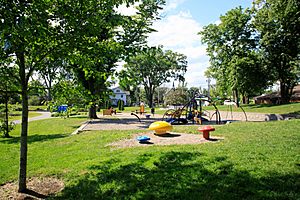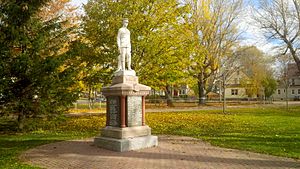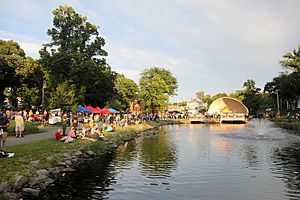Wentworth Park, Nova Scotia facts for kids
Quick facts for kids Wentworth Park |
|
|---|---|
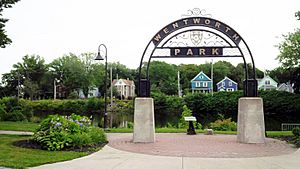
Byng Avenue entrance Arch
|
|
| Lua error in Module:Location_map at line 420: attempt to index field 'wikibase' (a nil value). | |
| Type | Municipal Urban Park |
| Location | Sydney, Cape Breton Island, Nova Scotia, Canada |
| Area | 14.5 acres (5.9 ha) |
| Created | 1786 |
| Operated by | Cape Breton Regional Municipality, Recreation, Parks & Grounds Department |
| Open | Year round |
| Status | Operational |
| Paths | Paved, 3 metres (10 ft) wide |
| Public transit access | Transit Cape Breton Route 13 |
Wentworth Park is a cool Canadian park in Sydney, part of Nova Scotia's Cape Breton Regional Municipality. It was created in 1786, just one year after Sydney was founded. This makes it the oldest park in Sydney!
The park has a Kiwanis Bandshell, a fun playground, pretty fountains, and a splash pad. There's also a 1.2 kilometer (0.75 mile) network of paved paths. These paths go around the park's ponds and flower beds.
Wentworth Park is built around Wentworth Creek, which forms a series of connected ponds. The park covers about 14.5 acres (5.9 hectares) right in the middle of the city's downtown area. Bentinck Street divides Wentworth Park into two parts. This street connects the Sydney Waterfront District to both ends of the park. You'll find a playground for younger kids in the east part of the park.
Contents
What Can You Do at Wentworth Park?
Enjoy Music at the Bandshell
People have been enjoying music at Wentworth Park for a long time! Even before the current concrete bandshell was built, musical shows brought crowds here. In 1915, the Sydney Woman's Council helped raise money for a round bandshell and flower beds. By 1917, a band called the Coronation Band played in the park. They entertained people who were paddling canoes in the Creek.
The old bandshell was replaced in 1960 with a new wooden one. Then, the Kiwanis Club built the brick and concrete bandshell you see today in 1962. In 1967, Sydney celebrated Canada's 100th birthday at the bandshell. There was a concert and even Queen Mother Elizabeth attended!
Play at the Playground
The park has a great playground for kids. It's a perfect spot to run around and have fun!
See the Orangemen War Memorial
The Orangemen War Memorial in Wentworth Park remembers members of the Orange Order from Cape Breton County. These were people who died serving in the armed forces during World War I. The Orange Order is a historical group that started in Ireland in 1795. It has been important in Canadian history, with many famous members.
The memorial was first placed in the park in 1921. Later, in 1946, a new part was added to also remember those lost in World War II. In 1999, the memorial was moved to a spot that is easy for everyone to access.
How to Get to the Park
- Transit Cape Breton Route 13 stops right at Wentworth Park all day.
- CBRM Handi-Trans can drop people off at the park entrance, especially for special events.
- The paved paths are smooth and easy to use for people with mobility aids.
- Restrooms are open during the summer months.
- Service animals are welcome. Other dogs are allowed on a leash, but not in the playground area.
- Parking is available west of King's Road. You can reach the park from there by a crosswalk or a pedestrian tunnel.
Fun Events at the Park
Makin' Waves Festival
Since July 2015, the Makin' Waves Festival happens every summer. Performers from all over Canada come to the Wentworth Park Kiwanis Bandshell. It's a family-friendly event every Thursday evening in July, starting at 6 PM. Admission is free! With a playground nearby and food trucks, it's fun for all ages.
The festival features well-known artists and different types of music. It also has family activities and a popular market. More than 10,000 people attended in 2019!
John Gracie Christmas Concert
Cape Breton Island singer John Gracie started a tradition of free Christmas Concerts in Wentworth Park in December 2007. These outdoor concerts happen every year on December 23rd at the bandshell. They feature classic Christmas songs. His duet with his daughter, Samantha Gracie, singing "Baby, It's Cold Outside" is a favorite! Free hot chocolate is provided by Tim Hortons. Admission is free, but donations are collected for The Salvation Army.
Park History: A Look Back
The Admiralty Reserve
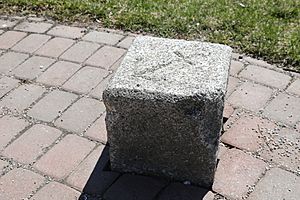
Wentworth Creek starts in the hills east of Sydney. It brings fresh water to the harbor. In the 1500s and 1600s, Spanish and Basque fishermen likely used it to get fresh water. This was a big reason why Joseph F.W. DesBarres chose Sydney as his colonial capital. That's why it was first called "Freshwater Creek."
In 1786, John Wentworth visited Sydney. He set aside valuable white pine trees along the creek for the Royal Navy to use. These trees were important for building ships. Wentworth marked a 100-foot (30-meter) strip on both sides of the Creek as "Admiralty Lands." This land was meant to be a government shipyard or a timber reserve. DesBarres named the stream "Wentworth Creek" to honor him.
In 1790, shipbuilding began in Sydney at the mouth of Wentworth Creek. The area where the workers lived is still called the Shipyard. A street there is named after Philip Ingouville, who built the first ship.
A bridge was built over the Creek on King's Road by the 1870s. The path along the north side of the Creek was once a quiet spot for young couples. It was known as "Lovers Lane" until 1926, when it was renamed Byng Avenue. This was to honor Governor General Byng, who visited Sydney.
The British government never used the land for a shipyard. Instead, they leased it out. Richard and Joseph Dobson built a dam on the Creek and a gristmill to grind grain. Photos from around 1895 show the old mill building near where the Bandshell is today. The Dobsons sold the mill to Murdock Morrison, who ran it until 1913. The road to the mill, now Argyle Street, was called the "Old Mill Road." In 1946, the city of Sydney bought the land.
In 1899, a railway bridge was built over the Creek. This bridge likely made it harder for ships to travel up the Creek. This was a big change to how the Creek was used.
The Park Takes Shape
Wentworth Park has been a key part of life in Sydney for over 200 years. While the park existed in 1786, it looked very different back then. Photos from the early 1900s show a park that people today would recognize.
In the early 1900s, houses were built along the Creek. But people still used the Admiralty lands as a park. Many boats and canoes were on the ponds, and families had picnics on the grass. In 1903, city officials decided to make the area a formal park. By 1913, the government suggested the city take over all the land not being leased for park use.
In 1923, land was added to make the lower end of the Creek narrower. In 1928, two swans were given to the park from the royal Swannery, and a swan house was built.
Finally, in 1934, the Canadian government took over the land from the Admiralty and gave it to the city. The last house on the property was removed in 1956. The city then made the park bigger, and by 1961, it reached its current size.
The park has changed less in recent times. The Kiwanis Club built the Bandshell in the 1960s, which was a major change. More recently, special baskets were put in place to stop the banks from wearing away.
Park Improvements: 2003-2010
In 2003, a plan was started to make Wentworth Park even better. People from the community shared their ideas for the park's future. In 2005, a group of volunteers called the "Friends of Wentworth Park Society" was formed. They helped guide the park's improvements.
Phase I: Western Section Upgrades
A big renovation of the park's western section began in 2005. King's Road, which borders the park, was rebuilt. This work made King's Road higher and changed how people accessed the park. A lighted tunnel was built under King's Road. This tunnel connects the park to the Sydney Waterfront Boardwalk and Rotary Park.
The renovations also included new paved paths with lights. The pond shores got natural-looking stone borders to stop erosion. A new concrete temple was built overlooking the pond. Three new floating fountains were added to help clean the water and light up at night. The old Ann Terry Memorial Plaza was replaced with a new interactive fountain, seating, and trees.
Phase II: Creek Improvements
The second phase of improvements started in 2008. This involved changes to Wentworth Creek itself. A large concrete box was built to extend the creek under the bandshell area. This created more space for people to sit and watch shows. Another concrete tunnel was added next to the creek to help prevent flooding during heavy rains. The pond shorelines were improved with natural stone. A sloped area was added to the pond for winter skaters. The small dam at Bentinck Street was upgraded, and a fish ladder was added to help fish move through the creek.
Phase III: Playground and Bandshell
The third phase of the project happened from 2008 into 2009. This included a new playground for younger kids. Paths were improved and lit up, and new trees were planted. The park's bandshell, a very important landmark, was also restored. A floating fountain that lights up at night was placed in the bandshell pond. A new entrance arch was created by artist Gordon Kennedy at Byng and Bentinck Streets. Kennedy also made artistic stands for signs that tell the park's history.
Grand Opening
A big celebration was held on Sunday, August 1, 2010. This marked the completion of the park's revitalization project!
Park Expansion
In 2005, an extra 1.5 acres (0.6 hectares) of land along King's Road was added to Wentworth Park. This area, which borders Sydney Harbour, was landscaped with trees and shrubs. A gravel path and a paved parking area were also created for visitors.
Images for kids



